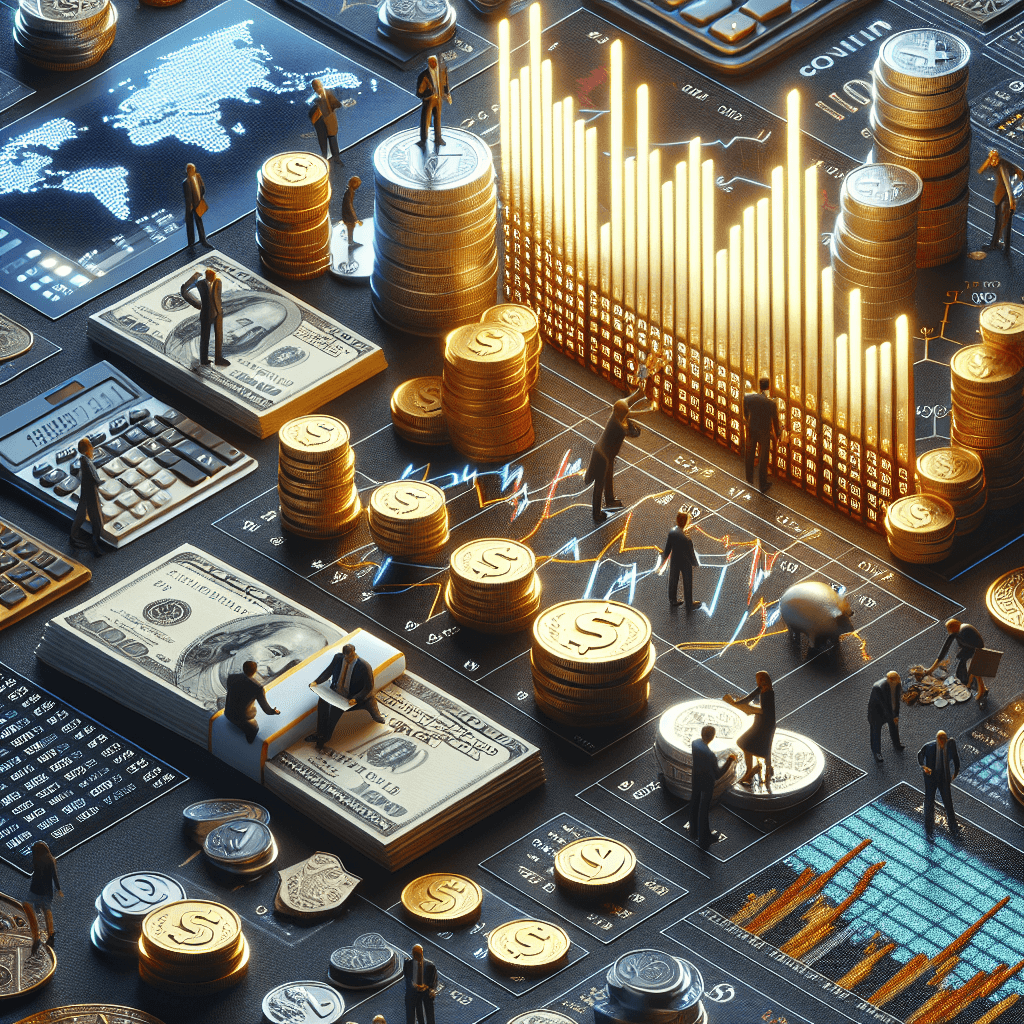What is a Prime Rate?
The prime rate is the interest rate that commercial banks charge their most creditworthy customers. It serves as a benchmark for other interest rates in the economy. This affects mortgage rates and credit card APRs. Understanding the prime rate can help you make informed decisions about borrowing and saving money. Let's explore what the prime rate is and how it affects your finances.
Definition of Prime Rate
The prime rate is the interest rate that commercial banks charge their most creditworthy customers.
It serves as a baseline for various types of loans, including mortgages, business loans, and lines of credit.
The prime rate is determined based on the federal funds rate set by the Federal Reserve.
This rate influences how much banks charge each other for overnight loans.
When the Federal Reserve increases or decreases the federal funds rate, banks adjust their prime rates accordingly.
This, in turn, affects the interest rates consumers and businesses pay on their loans.
For example, when the prime rate increases, borrowing money becomes more expensive.
This leads to higher interest rates on credit cards, mortgages, and other loans.
Understanding the prime rate is useful for borrowers seeking favorable loan terms.
It directly impacts the cost of borrowing and lending in the economy.
Historical Prime Rates
Prime Rate Changes in 2006
In 2006, prime rate changes were influenced by various factors. The Federal Reserve adjusted the federal funds rate, impacting interest rates on loans. Commercial banks like Commerce Bank closely monitored these changes to adjust their lending rates. Fluctuations in prime rates directly affected mortgages, credit cards, and other lines of credit offered to customers. These changes were tied to economic indicators like inflation, influencing the Federal Open Market Committee's decisions.
As prime rates increased or decreased, borrowing and lending decisions by financial institutions and consumers were directly impacted. The Wall Street Journal reported these adjustments, affecting business loans, student loans, personal loans, and investment decisions. Banks tailored their services to creditworthy customers by offering variable rate mortgages, home equity loans, and adjustable-rate mortgages that reflected the prime rate adjustments.
Prime Rate Changes in 2007
In 2007, the prime rate went up and down, affecting different financial areas. These changes impacted how much interest people paid on things like loans for houses, credit cards, and lines of credit from banks.
The Federal Reserve, especially the Federal Open Market Committee (FOMC), played a big part in deciding these rate adjustments, which are closely linked to the federal funds rate. Things like how well the economy was doing, high prices, and how reliable customers were affected these rate changes.
If the prime rate went up, it meant that it cost more for businesses and people to borrow money. This affected things like variable rate mortgages, home equity loans, and adjustable-rate mortgages.
The Wall Street Journal often talked about these rate changes, showing how they impacted borrowing and lending in the market. Also, Commerce Bancshares, which is part of the FDIC, had to match its rates with the prime rate changes to stay competitive.
To sum it up, the prime rate changes in 2007 had a big impact on how people borrowed and lent money. It showed how interest rates are connected to how well the overall economy is doing.
Prime Rate Changes in 2008
In 2008, several factors impacted prime rate changes:
- The global financial crisis
- High inflation
- Economic growth fluctuations
These events led to significant adjustments in interest rates throughout the year. The Federal Reserve's actions in response to market conditions influenced the fluctuations in the prime rate. This affected various financial products such as loans, mortgages, credit cards, and lines of credit.
- Some borrowers experienced increased borrowing costs
- Others benefited from lower rates on loans like student loans, personal loans, and business loans
- Mortgage rates, especially variable rate mortgages and home equity loans, were also affected
Qualified customers looking to refinance or secure new loans were impacted by these changes. Wall Street Journal and financial experts closely monitored the shifts in lending and investment strategies in response to economic uncertainties.
Prime Rate Changes in 2015
In 2015, the prime rate went up and down from previous years due to factors like economic growth, high inflation, and the federal funds rate set by the Federal Reserve.
These changes directly affected borrowers and savers. Borrowers saw differences in interest rates on various loans such as mortgages, student loans, personal loans, and business loans.
The prime rate had an impact on variable rate mortgages, home equity loans, and adjustable-rate mortgages, which affected decisions on refinancing for many homeowners.
For lenders, the prime rate determined the base for interest rates on lines of credit and other loans.
Commercial banks and other financial institutions closely watched the prime rate to adjust their rates for borrowing and lending accordingly.
Prime Rate Changes in 2016
In 2016, the prime rate had fluctuations. It affected financial products like loans, credit cards, and mortgages. These changes were due to the Federal Reserve adjusting the federal funds rate. This influenced borrowing and lending rates for both banks and customers.
Factors like FOMC meetings, economic growth, inflation rates, and the Federal Reserve's decisions on monetary policy were significant in determining the prime rate adjustments. These changes directly affected consumers looking for loans, especially through variable interest rates on products like mortgages and lines of credit.
Financial institutions, including commercial banks, closely watched the prime rate changes to adjust their lending rates accordingly. Customers, especially those with good credit, saw changes in interest rates on various products, from student loans to investment opportunities.
The prime rate changes in 2016 had a big impact on how qualified customers found financial solutions.
Prime Rate Changes in 2017
The prime rate changed a lot in 2017. This affected different financial sectors. Factors like the Federal Reserve's decisions, economic growth, inflation levels, and lending practices of banks all had an impact. Specifically, the Federal Open Market Committee meetings decided on changes in the federal funds rate. This affected the prime rate, which then influenced interest rates on loans, mortgages, credit cards, and lines of credit.
High inflation made borrowing more expensive for customers wanting personal or business loans. But when the economy was doing well, rates were lowered to encourage more investment. Commerce Bank and other financial institutions paid close attention to Wall Street Journal reports to see how the prime rate was changing. They adjusted variable interest rates on products like variable rate mortgages and home equity loans accordingly.
Throughout the year, borrowers and lenders kept up with the changes in the financial markets, whether the prime rate went up or down.
Prime Rate Changes in 2018
In 2018, the prime rate went up and down. It affected things like loans, mortgages, credit cards, and lines of credit.
Financial institutions, like Commerce Bank, keep a close eye on prime rate changes. They usually do this when the Federal Reserve changes the federal funds rate. Things like economic growth, inflation, and decisions made by the Federal Open Market Committee can cause these changes.
For people who have loans with variable interest rates, like student loans or adjustable-rate mortgages, these ups and downs affect how much they pay each month.
Mortgage rates, home equity loans, and business loans may also have felt the impact. To stay updated, people often check the Wall Street Journal or other websites that give financial information.
It's important for consumers to be cautious when exploring offers tied to these interest rate changes. Checking the security and privacy policies of financial institutions is essential to protect personal information.
Prime Rate Changes in 2019
Throughout 2019, the Prime Rate had many ups and downs. The Federal Reserve's decisions on the federal funds rate influenced the Prime Rate directly. This affected loans, mortgages, credit cards, and lines of credit offered to creditworthy customers by financial institutions.
The Prime Rate moved in line with the changes made by the Federal Open Market Committee. Economic growth, inflation rates, and high inflation expectations were indicators that prompted these adjustments.
When the Federal Reserve's target rate increased, the Prime Rate also went up. This impacted borrowing and lending rates for businesses and individuals.
Keeping up with economic news from sources like The Wall Street Journal was important to understand how these changes could affect investments and loan applications.
In 2019, the collaboration between the Federal Reserve's decisions, economic indicators, and financial institutions' responses played a big part in shaping Prime Rate changes.
Prime Rate Changes in 2020
Prime Rate changes in 2020 were influenced by various factors.
The Federal Reserve, specifically the FOMC, adjusted the Federal Funds Rate.
This affected the Prime Rate set by commercial banks like Commerce Bank.
Interest rates moved up and down in response to economic conditions.
This impacted loans, mortgages, credit cards, and lines of credit for businesses and individuals.
Throughout 2020, Prime Rates were adjusted based on economic growth, inflation rates, and lending practices.
Financial institutions, Wall Street Journal readers, and creditworthy customers closely monitored these changes.
Changes in rates influenced borrowing and lending behaviors, leading to adjustments in business loans, student loans, personal loans, and investments.
Customers looking at variable rate mortgages, home equity loans, or adjustable-rate mortgages watched Prime Rate shifts for refinancing opportunities.
This year showed how Prime Rate changes directly affect the financial situation, reflecting the broader economy.
Factors That Influence Prime Rate
Economic factors like inflation, economic growth, and high inflation can affect the prime rate. The Federal Reserve adjusts the prime rate by changing the federal funds rate. That, in turn, impacts interest rates on loans and credit cards from banks.
Market conditions, such as borrowing and lending demand, also influence the prime rate. During economic growth, the prime rate may go up due to increased loan demand. Commercial banks adjust their prime rates to attract reliable customers and boost investment based on these conditions.
Variable rate mortgages, lines of credit, and business loans often relate to the prime rate. They can increase or decrease based on changes set by financial institutions. Websites often discuss online privacy policies, terms of service, and copyright materials, including those from firms like Commerce Bancshares.
Why Should You Pay Attention to Prime Rate?
The prime rate, set by financial institutions like Commerce Bank, is important for the economy and financial markets. It affects interest rates on various loans like mortgages, credit cards, student loans, and business loans.
The Federal Reserve controls the prime rate by adjusting the federal funds rate during FOMC meetings. When the prime rate goes up, borrowing becomes more costly, potentially slowing economic growth, especially during high inflation periods. In contrast, a decrease in the prime rate can encourage borrowing and investment.
Consumers and businesses should closely follow these changes as they affect their ability to borrow and lend money. For instance, variable rate mortgages and home equity loans are linked to the prime rate, impacting monthly payments.
By monitoring the prime rate, consumers can make informed financial decisions and benefit from favorable interest rates. Keeping an eye on the prime rate through sources like the Wall Street Journal or financial websites can help individuals stay informed about their financial choices and plan ahead.
Conclusion
A prime rate is the interest rate that commercial banks charge their most creditworthy customers, typically large corporations.
It serves as a benchmark for other interest rates in the economy, impacting lending rates for various financial products such as mortgages, credit cards, and business loans.
The prime rate is influenced by the federal funds rate set by the Federal Reserve. It reflects the current economic conditions and the level of risk associated with borrowing money.
FAQ
What is the prime rate?
The prime rate is the interest rate that commercial banks charge their most creditworthy customers. It serves as a benchmark for other interest rates, such as those for loans and mortgages. For example, if the prime rate is 3.25%, a credit card company may charge 10% above prime for its cards.
How is the prime rate determined?
The prime rate is determined by the Federal Reserve and is influenced by the federal funds rate. It is set based on the borrowing rates between banks and is typically used as a benchmark by lenders when determining interest rates for consumer loans.
Why is the prime rate important?
The prime rate is important because it influences interest rates on various financial products like credit cards and loans. Changes in the prime rate impact borrowing costs for consumers and businesses, influencing spending and saving decisions.
How does the prime rate affect consumers?
The prime rate affects consumers by influencing interest rates on loans and credit cards. When the prime rate goes up, consumers may face higher borrowing costs, while a decrease in the prime rate typically means lower borrowing costs for consumers.
Can the prime rate change over time?
Yes, the prime rate can change over time. It is determined by the Federal Reserve and is influenced by various factors such as inflation, employment rates, and economic conditions. It is typically updated in response to changes in the economy.


